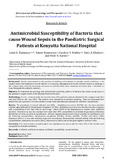| dc.contributor.author | Elamenya, Linet K. | |
| dc.contributor.author | Nyamweya, Nasser | |
| dc.contributor.author | Wafula, Caroline N. | |
| dc.contributor.author | Okalebo, Faith A. | |
| dc.contributor.author | Karimi, Peter N. | |
| dc.date.accessioned | 2015-12-01T06:51:36Z | |
| dc.date.available | 2015-12-01T06:51:36Z | |
| dc.date.issued | 2015 | |
| dc.identifier.citation | Elamenya, L. K., Nyamweya, N., Wafula, C. N., Okalebo, F. A., & Karimi, P. N. (2015). Antimicrobial Susceptibility of Bacteria that cause Wound Sepsis in the Paediatric Surgical Patients at Kenyatta National Hospital. African Journal of Pharmacology and Therapeutics Vol, 4(1), 21-27. | en_US |
| dc.identifier.uri | http://hdl.handle.net/11295/92737 | |
| dc.description.abstract | Background: Despite improvement in the practice of medicine and attempts to provide aseptic conditions in the
surgical wards, the incidence of wound infection is increasing. Management of wound infection remains a challenge in
the surgical areas with the increasing resistance to antimicrobials. Local bacterial sensitivity data is therefore an
important guide for antibiotic selection.
Objective: To determine the aetiology and antimicrobial sensitivity patterns of bacteria that cause wound sepsis in
the paediatric surgical wards at the Kenyatta National Hospital.
Methodology: A cross- sectional study was carried out on 150 paediatric patients admitted in the surgical wards from
mid April 2014 to mid June, 2014. The patients were selected by convenient sampling. Data was abstracted from
patient files and specimens from the infected wounds were identified and analyzed for antibiotic susceptibility.
Results: The prevalence of wound infection was 82%. Staphylococcus aureus (52.7%) was the most prevalent
infective agent followed by Pseudomonas aeruginosa (17.3%). Staphylococcus aureus was the most resistant organism
with susceptibility of less than 50% to most drugs. About 50.6% of the Staphylococcus isolates were methicillin
resistant. Streptococcus was less resistant with more than 80% susceptibility to all tested drugs except cefuroxime.
Escherichia coli were sensitive to ciprofloxacin. All gram negative bacteria were highly sensitive to ciprofloxacin with
the following susceptibilities: Pseudomonas aeruginosa (92.3%), Proteus mirabilis (71.4%) and others 100%.
Imipenem which is a new and relatively expensive monobactam demonstrated reduced activity with the following
susceptibilities: Staphylococcus aureus (38%), Streptococcus (80%) and all the gram negative bacteria (70%).
Conclusion: The most common causative agent was Staphylococcus aureus and less than 50% of the isolates were
susceptible to all tested antibiotics. | en_US |
| dc.language.iso | en | en_US |
| dc.publisher | University of Nairobi | en_US |
| dc.subject | Antibiotic, antibiotic resistance, antibiotic susceptibility, wound infection. | en_US |
| dc.title | Antimicrobial susceptibility of bacteria that cause wound sepsis in the paediatric surgical patients at Kenyatta National Hospital | en_US |
| dc.type | Article | en_US |

